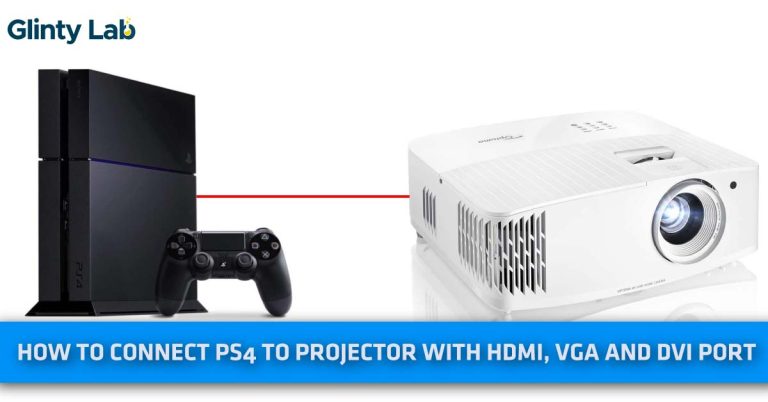Types of Projector Screens – How To Choose Appropriate One
In this guide we have listed various types of projector screens, You will learn how to choose the most appropriate one for you.
As you might know, projectors need a specific area to project their display. That specific area may be a screen or painted wall.
We have received hundreds of quires that we have purchased our desired projector, know which screen we should choose for. This guide will help you to choose your desired projector screens
Let me clarify first that the choice of screens solely depends on the purpose of usage, you must identify why you are going to purchase a screen. some person needs portability however others want a fixed screen, similarly, some want to operate their projector in ambient while others want to operate in dark.
Letís explore the different types of projector screens available in the market.
Types of Projector Screens
1. Electric/Motorized Retractable Screen:

Motorized projector screens are the most convenient option for those who want to hide the screen by pressing a button.
Yes, these kinds of the screen have an electric mechanism and a sufficient space of metal or plastic on the top to roll up the screen like a garage door, simply you will have a remote control or button beside the screen to roll up it. I use this screen for my presentations, conference, or smaller room due to its elegant look and space-saving design as well.
Moreover, the electric screens come with non-tensioned and tensioned mechanisms, letís have a look at them side by side.
Non-tensioned: These kinds of electric screens donít have the functionality to properly straighten the screen. You may find waviness and winkles on the non-tensioned screen.
Tensioned: These kinds of the screen have built-in sensors and motors to straighten the screen perfectly, just you need to press the button rest will do its inner mechanism, literally you will find a screen like a mirror.
What We like About Electric Screens
- They are elegant and space-saving.
- They donít need your efforts just you have to press the button.
- Long-lasting.
- Voltage flexibility they can work on 100 to 220 voltages
What I donít like About Electric Screens
- They are expensive.
- May need help from a professional to install it.
- Need maintenance of motors, and hiding chamber.
2. Fixed Frame Screens:
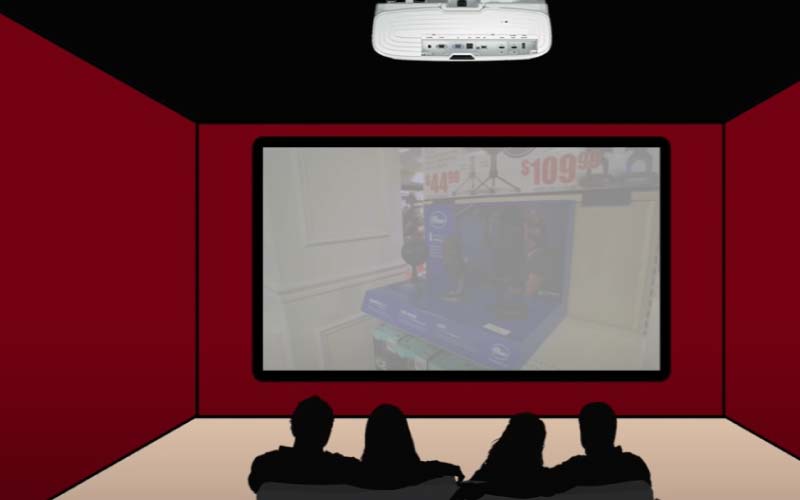
Fixed frame screens donít have the functionality to hide the screen, you will have a fixed frame with a fixed screen to show your projector’s screen.
Though they are not that convenient and cool, still, fixed frame screens are the favorite of home theater owners, I prefer a high-end fixed frame screen over any other screen like electric, manual, etc.
What We like About Fixed Screen
- They are perfectly straightened within a fixed canvas you will never find waves and bends.
- The fixed screen comes in lots of varieties because of the high demands of home theater owners; you will found multiple fabrics, colors, etc.
- Cost-effective.
- Easy to install and maintain.
What We donít like About Fixed Screen
- The medium models of fixed screens are not that expensive but if you are going to get a high-end screen you will have to pay even more than an electric screen.
- You must have a space allocated to the screen there is no availability to retract them.
3. Manual Screens:
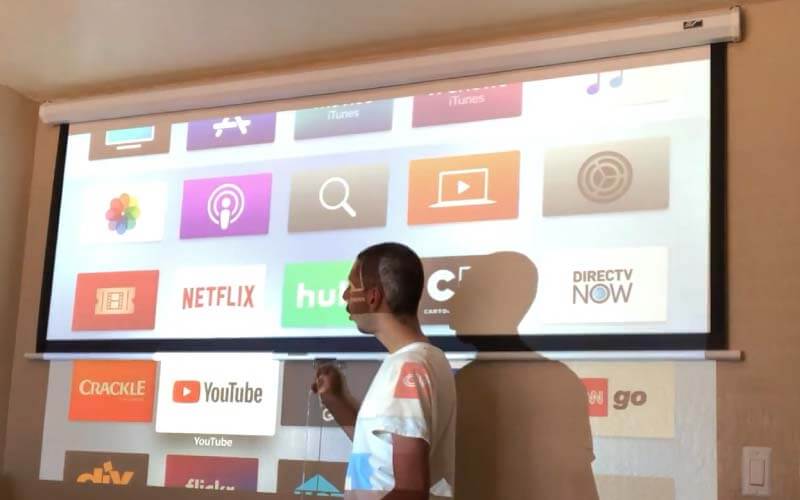
Manual screens are widely popular for having a retractable functionality within a mid-range price tag; yes you will have an option to roll up the screen manually with a pulley. You just need to pull the pulley to hide or expose the screen.
Manual screens are widely found in classrooms and small home theaters as well, as they are not expensive yet space-saving, if puling is not a problem for you manual is best over electronic.
Other than that the modern manual screens have a controlled return function your screen will be safe from any damage, also, you will find tensioned and un-tensioned versions like electronic screens. You may pay more for the tensioned version as they will not have waviness and bends.
What We Like About Manual Screen
- They are cheap yet retractable.
- Also, we have tensioned and un-tensioned versions.
- Safe from any damage because of controlled return functionalities
What We don;t Like About Manual Screen
- Doesnít have automation, we need to do manual work.
4. Portable Screens:
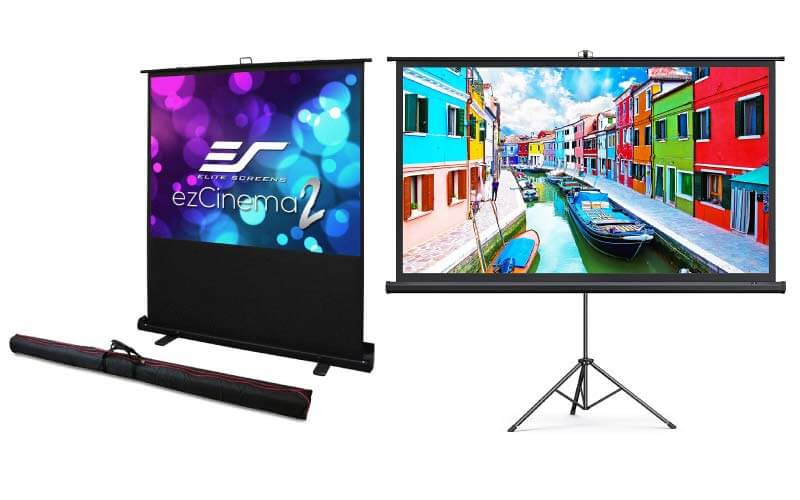
These types of projector screens can be folded to the minimum length so that we can carry them without any hurdle, also they have a tripod or any other things to stand them.
Portable screens are solely built to use during traveling and outdoor activities, in most cases we need projector screens more frequently on different occasions like outdoor parties, immediate conferences, etc. in that cases portable screens are our best friends of us.
Learn how to use a projector outside while you are at it.
What I Like About Portable Screens
- They are ultra-flexible to carry even during traveling.
- Portable screens are durable, light Wight and collapsible.
- Mid-range price tag.
- Best for mini projectors which can project medium screen.
What I donít Like About Portable Screens
- Comes With limited screen sizes, you will struggle to get huge portable screens.
5. Projectors Screen Paint:
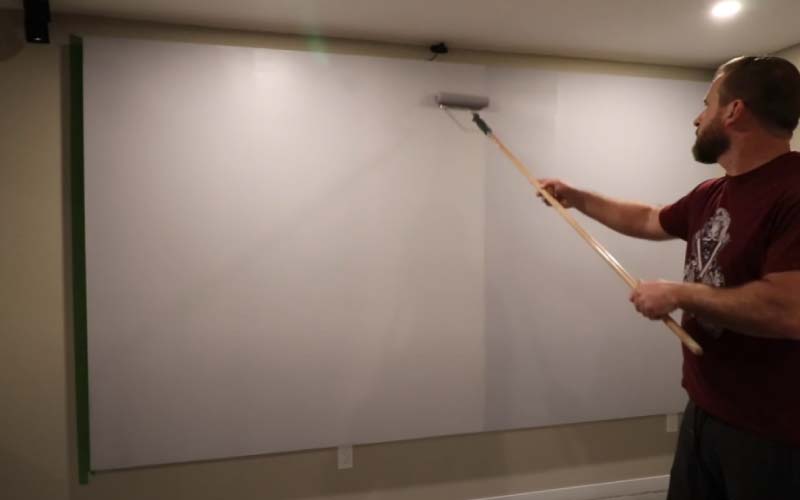
Projector Screen Paint is the best alternative to expensive projectors screen; I just need a gallon of black or white projectors screen to make a 100 to 200 inches diagonal screen; however, it costs me about $100 to $200 depending on the quality of paint.
Other than that you just need to mark the area you want to paint and a roller to start your work. I didnít hire a professional.
What We Like about projectors Screen Paint
- We donít need to spend hundreds of bucks on expensive screens.
- Space-saving option.
- Required less maintenance.
- No installation cost.
What We donít Like about projectors Screen Paint
- No portability.
- may cost even more then a screen if you want a high end projector screen paint
- It May does not blend with your room color.
- doesn’t last longer
6. Inflatable Projector Screen:

The type of screen that can be inflated like a mini pool or air mattress etc. you just need to fill the air in the tube to reveal a big screen.
Inflatable Projector screens are ideal for backyards, outdoor activities, and drive in Movies Theater as you donít need to ruin your bad sheets to make a DIY screen.
This revolutionary technology constantly dominates the market due to its easy usage, impressive picture quality, and can withstand extreme temperature, rain, and real winter, forget about the outdoor elements these screens are designed to combat with them.
Other than that these screens have a self-inflate option to inflate within a minute without waviness or bends, even I donít need to adjust any things, just I need to pick a chair and enjoy the serials.
What We Like About the Inflatable Projector Screen
- Extremely portable, you just need to inflate it where you want to make your movie theater.
- Provide a bending and waviness-free screen, perfect to view from any angle.
- Mid-range price-tag.
- Easy to install and can withstand high winds, rain, and harsh temperature.
What We donít Like About the Inflatable Projector Screen
- You need to add anchors on the sides and middles to a stable screen, otherwise, your screen will vibrate because of wind.
- Require a blower to inflate it.
7. Type of projector screens – DIY Projector Screens:
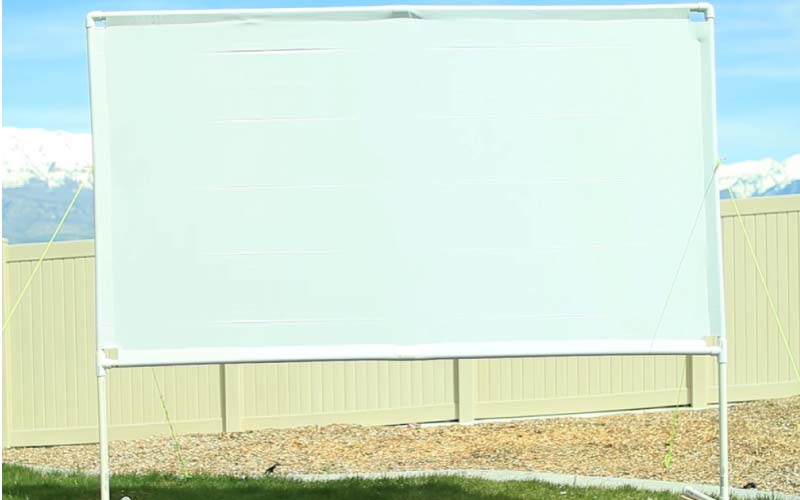
Some creative guys can save their bucks by making their DIY projectorís screen by using a sheet, projector screen paint, wrapping paper, or even they can use a roller shade to make an impressive projector screen.
One of my friends has built a DIY screen from a sheet, he only uses a frame, a high-quality sheet, and a big piece of cardboard to support the screen. It is not necessary to build a DIY screen from plastic sheets, woven sheets, etc. you can make it with screen paint at cheap.
What We Like About the DIY Projector Screen
- The inexpensive alternative of expensive screens.
- Versatile options for materials like paint, sheets, etc.
What We like About the DIY Projector Screen
- Less picture quality in terms of brightness, sharpness, blacks, etc. because readymade screens are built from high grains reflective glassy material to provide utmost picture quality.
- Portability issue, you canít carry it anywhere. If you are the guy who can make a motorized DIY screen then you can carry it anywhere otherwise cheapest options are not convenient.
- Not long-lasting as compared to the readymade.
- Not a big money saver if you are going to purchase high-end sheets or screen material.
checkout our guide about how to build DIY projector screen
8. Rear Projector Screen:
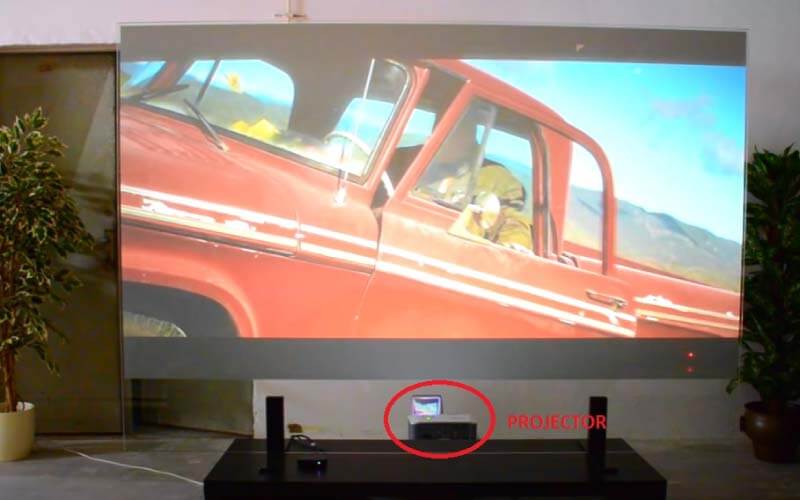
A rear projector screen works when you put the projector behind the screen, unlike other screens these screens will provide you extremely vibrant colors, decent brightness, and contrast because you have to place the projector near to the screen without distracting the beam.
As the rear projector project towards the users, you may find T.V like display; still, the difference will be visible between T.Vs and rear screens.
What We Like About Rear Projector Screens
- They are space-saving, projector, cables, etc. can easily hide behind the screen.
- Extremely bright with vibrant colors, can work in ambient as well.
- The projector beam will be safe from blockage.
- Since this technology needs a projector behind the screen you will be free from any noise.
What We donít Like About Rear Projector Screens
- They are expensive.
- They require short throw projectors.
- The screen should have light-absorbing properties, not reflective properties otherwise brightness will be reflected.
- The rear screens are thin, need ultra-care.
You can get a detailed comparison between the rear and front projector screens here
Types of Projector Screens By Mounts
1. Wall Mounting Screens:

Have you ever seen a framed photo or artwork on the wall, wall-mounted screen seems similar to this; you will have a large canvas to put the screen and fix it on your wall.
Most of the home theater or movie theater owners have wall-mounted screen setups because they are super stable with the support of wall and screen frames.
Wall-mounted screens canít unmount and mount again and again because we have to screw them tightly, though you can unmount them when you are going to shift your setup to another room, not 2 or 3 times a day.
2. Celling Mounting Screens:
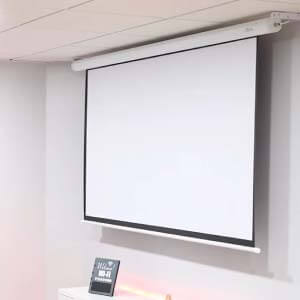
Celling screens have a super unique mechanism to mount the screen on the ceiling; they mostly have folding apparatus to save your space.
Simply you have to mount the screen on the ceiling and press the remote control to reveal the screen, however, if your screen is manual you have to turn the pulley.
NOTE: Not if you need top-notch stability keep your ceiling screen close to the wall as much as you can, the wall will provide strong support to stable your screen from any type of vibrations.
3. Floor Rising Screens:
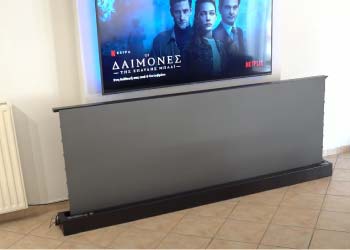
Opposite of celling screens, they are mounted on the floor instead of celling, and they also have foldable apparatus to reveal or unravel the screen.
Most of the projectors’ geek doesnít want their screen on the ceiling because of maintenance and installation hurdle.
Other than that I don’t need to mount these screens on the floor, just I need to place them because their base is super stable, after watching my serials I deceased them and place them at a safe place. also, they allow me portability as well.
4. Tripod Screens:
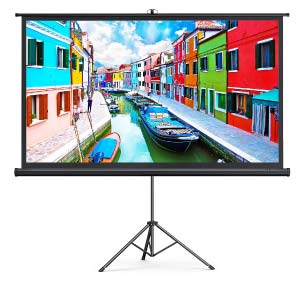
Just like a camera tripod, these screens have a big tripod mounted on the bottom, you just need to stand the screen on the tripod and press the button or lever to reveal it. Of course, the tripod and screen will be in portable conditions, just like an umbrella, still, they are somehow heaver because of the heavy metal frame and tripod itself.
Tripod screens will be convenient for those who want to do business presentations on versions locations or want to enjoy outdoor movies etc.
5. DIY Mounts Screens:
Like DIY screens you can make a DIY
mount as well.
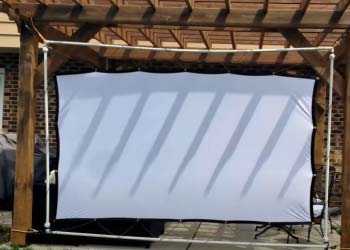
One of my friends has an amazing DIY mount for her 120 inches screen, simply she has made a frame of metal and attaches a pair of wheels on the bottom to freely move the screen.
Other than that I have built a wooden fixed frame for my projector screen, I just spend 40 bucks to get all kinds of stuff like a wooden frame, cart board screws, etc.
DIY mount is amazing for those who want to save their $ but you need to be creative and technically good to make your screen properly, otherwise, you may ruin your screen material.
Wrapping Up
We have listed almost all types of projector screens, you just need to read them to get detailed ideas about what you should want to get. Since different screens have different purposes for users like you canít use the inflatable screen on home theater, similarly you canít use a fixed screen in outdoor, etc.
Here are some recommendations from us to utilize every type of projectorís screen properly.
Fixed: Best for home theater and Movie Theater.
Electronic and manual screen: Best for offices, schools, conference rooms, etc. though they can be used in the home theater still I will not prefer.
Portable and inflatable screens: Best for outdoor activities like a beach party, pool party backyard Bar B Q party, etc.
Rear screen: Best for those who want high brightness, colors, and contrast, if budget is not a problem rear screen will blow your mind.
Projector Paint and DIY:† Best for those who want an average quality picture within a cheap price bracket.
Thanks for Reading Out
Frequently Asked Question-FAQs
Q: Does the type of projector screen matter?
Yes, every type of projectorís screen is made for different purposes like some of them are convenient for
Portability and others are not convenient for portability; on the other hand, some will provide you desired picture while others will not.
Q: How much should I spend on a projector screen?
It depends more you spend more you will get in terms of durability, picture quality, etc. generally decent projector screen starts from $100 to $1000.
Q: Does a 4K projector need a special screen?
Yes, if you have a native 4k projector you need a 4k screen to reflect light tremendously however a normal high-quality screen is sufficient for a non-native 4k projector.
Q: Is a projector screen better than a wall?
Yes in terms of lasting and picture quality projectors screens are way better than paint because their material is built to reflect light more efficiently. Though modern screen paints have that property still, I didnít get a paint that competes for the screens.
Q: Which is the better black or white projector screen?
The black screen is performing well in dark environment with much better, blacks, contrast, and colors, however, white screen performs well in modest ambient because of high reflecting properties,
The bottom line is black is slightly better if you are a deeper black, contrast, and colors lover but it needs a darker room to perform well. On the other hand, a white screen can perform well in modest ambient.
Q: Are elite projector screens good?
Yes, if you have an expensive native 4k projector go for an elite screen to enjoy a mind-blowing experience otherwise you can get your work done with mid-range screens.
Q: Can I use a projector without a screen?
Yes, you can use paint or any other DIY stuff to make a screen, but keep in mind ultimately you need an object to reflect the projectorís beam.
Q: Are projector screens worth it?
As we have stated that projectors’ screens are made from special material to reflect light more properly, you will get better colors, brightness, and overall picture quality on the projector screen.
The bottom line is yes they wort it.
Q: Are projector screens better for your eyes?
Yes, because they reflect light not emitted, your eyes will be safe from blue light and other harmful radiations.
Q: Are foldable projector screens any good?
They are extremely portable and space-saving, if you are a user who needs to travel with a projectorís screen or want to carry your screen to a beach party this is for you.
Q: How far can a projector be from the screen?
It depends on the projection ratio of the projector, you will find the Ultra short throw projector, short-throw projector and long-throw projector choices are yours.
Q: Can I use a sheet for a projector screen?
Yes, you can but the result will be no more than average.
Q: Can a projector project on a black wall?
Yes, if your room is a dark cave and your projector have fewer lumens, otherwise you need high lumens to perform well with the black wall in modest ambient
Q: What color wall is best for a projector?
Depending on the ambient light of the room and the lumens of the projector, if your projectors have fewer lumens go for white paint as white paint reflects more lights, also you have to select white paint if your room is more vulnerable to ambient light.
On the other hand, if your projector has high lumens you can use a black or gray screen.
Q: Can you use a projector on a pink wall?
Yes,† but the quality may be compromised as per our experience we only prefer black or white colors.

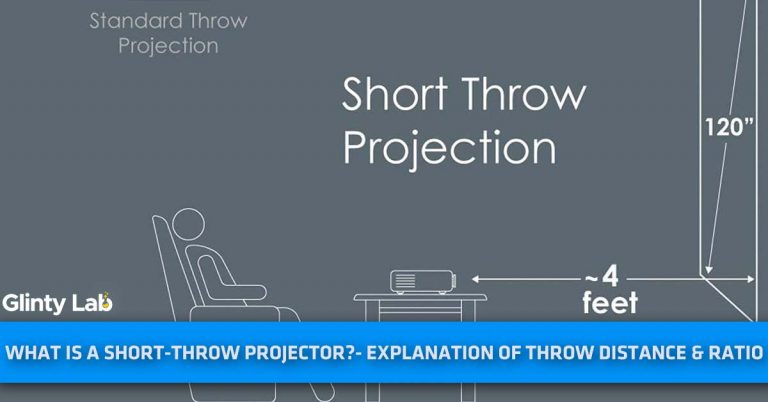
![How To Clean A Projector Screen In An Instant? – [Step By Step Guide]](https://glintylab.com/wp-content/uploads/2021/05/how-to-clean-a-projector-screen-768x402.jpg)

![How to Connect Soundbar to Projector? – [4 Easy Methods]](https://glintylab.com/wp-content/uploads/2022/04/How-to-Connect-Soundbar-to-Projector-768x402.jpg)
